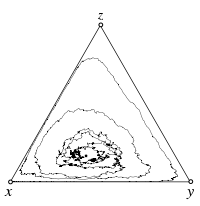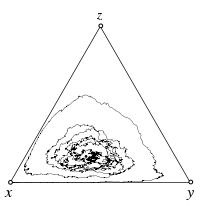Stochastic dynamics in finite populations
In infinite, well-mixed population, the fraction of players can change continuously, as described by the replicator dynamics in well-mixed populations. But in finite populations of size [math]\displaystyle{ N }[/math], the fraction must change at least by [math]\displaystyle{ 1/N }[/math].
In this case microscopic probabilities have to defined that describe how a player switches strategy, as in spatial evolutionary games. There are many ways to define such microscopic evolutionary process. In each of them, strategies that lead to higher payoffs are more likely to spread in the population. For example, two players can be chosen at random to compare their payoffs. The probability that a player adopts the strategy of the other player can be a linear function of the payoff difference. If only better strategies are adopted, the direction of the dynamics becomes deterministic in 2×2 games. But if also worse strategies are sometimes adopted with a small probability, then even a dominant strategy will only take over the population with a certain probability. This approach provides a natural connection between evolutionary game theory and theoretical population genetics, where such probabilities are routinely studied.
Besides the game, two parameters describe the dynamics: The population size [math]\displaystyle{ N }[/math] and the intensity of selection [math]\displaystyle{ w }[/math], which measures how much the adoption of someone else’s strategy depends on the payoffs. If the product of [math]\displaystyle{ w }[/math] and [math]\displaystyle{ N }[/math] is small, one speaks of weak selection and the dynamics is a small correction to random drift. If the product is large, then a deterministic replicator equation is recovered from finite population dynamics.
For weak selection, several new features appear in the system: In a bistable situation, one strategy can displace the other. Thus, a new concept of evolutionary stability is necessary. If we consider a single mutant in a population of size [math]\displaystyle{ N }[/math], it will take over the population with probability [math]\displaystyle{ 1/N }[/math] without selection, because each individual is equally likely to eventually become the ultimate ancestor. Adding a little amount of selection, a mutant is first disfavored in a bistable situation, but once it has reached a critical fraction, it is favored. The probability that a mutant will take over is a global measure for this process. Interestingly, this probability is larger than [math]\displaystyle{ 1/N }[/math] if the mutants become advantageous at a frequency larger than [math]\displaystyle{ 1/3 }[/math] and smaller then [math]\displaystyle{ 1/N }[/math] otherwise, independent of the other details of the underlying game. This result holds for many evolutionary processes under weak selection. Using tools from population genetics, it can be proven that it holds for all processes within the domain of Kingman’s coalescence.
From finite to infinite populations
Deterministic Dynamics
Stochastic Dynamics
Individual Based Simulations
References
- Traulsen, A., Claussen, J. C. & Hauert, C. (2012) Stochastic differential equations for evolutionary dynamics with demographic noise and mutations. Phys. Rev. E in print.
- Traulsen, A., Claussen, J. C. & Hauert, C. (2006) Coevolutionary dynamics in large, but finite populations. Phys. Rev. E 74 011901.
- Traulsen, A., Claussen, J. C. & Hauert, C. (2005) Coevolutionary Dynamics: From Finite to Infinite Populations. Phys. Rev. Lett. 95 238701.



